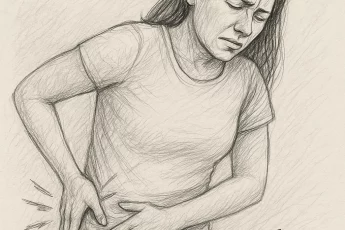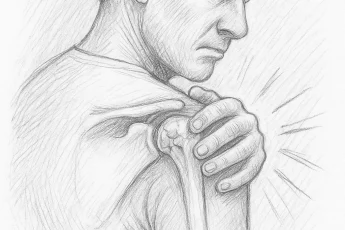As a Musculoskeletal GP, joint injections for arthritis are among the most common and effective treatments I provide at my private clinics in Cheltenham and in other locations across Gloucestershire. Joint injections can significantly reduce pain and inflammation, providing a crucial step towards regaining mobility and improving your overall quality of life. However, to achieve the best possible outcomes, joint injections are most effective when integrated into a comprehensive treatment strategy, typically involving physical therapy and lifestyle modifications.
Understanding Joint Injections
Joint injections involve delivering medication directly into or around a joint. This targeted approach ensures the medication acts precisely where it’s needed most, offering effective relief from pain and inflammation. They’re frequently employed in treating conditions such as osteoarthritis, rheumatoid arthritis, bursitis, and various tendinopathies.
Common and Specialised Injection Sites
Injections are commonly administered in and around joints :
- Knee: Commonly treated for osteoarthritis and cartilage injuries.
- Shoulder: Effective for conditions like frozen shoulder, rotator cuff injuries, and impingement syndrome.
- Hip: Helpful for conditions such as osteoarthritis and trochanteric bursitis.
- Elbow: Frequently used for tennis elbow and golfer’s elbow.
- Hand & Wrist: Beneficial for carpal tunnel syndrome, trigger finger, and thumb arthritis.
- Foot & Ankle: Useful for conditions like plantar fasciitis, ankle arthritis, and Achilles tendinopathy.
Additionally, my practice often extends to injecting more technically challenging joints. For example, I recently performed an ultrasound-guided injection into a patient’s radiohumeral joint, a joint located between the radius (forearm bone) and the humerus (upper arm bone), which effectively alleviated severe elbow pain that had not responded to previous treatments. Similarly, injecting an ankle joint under ultrasound guidance notably improved a patient’s mobility. I find injecting finger joints incredibly rewarding, particularly for those with severe arthritis, dramatically enhancing independence and reducing their reliance on pain medications and assistance from others.
Types of Joint Injections
1. Corticosteroid Injections
These injections primarily reduce inflammation, providing quick and substantial pain relief.
- Effectiveness: Strong evidence for short-term relief in osteoarthritis, rheumatoid arthritis, and bursitis (Versus Arthritis).
- Onset: Typically within 1–2 days, although in some cases may take up to a week.
- Duration: Relief can last several weeks to months depending on the condition.
- Side Effects: Temporary pain flare, facial flushing, raised blood sugar (particularly in diabetes), menstrual irregularities.
- Cautions: Avoid if you have an active infection, poorly controlled diabetes, or if you’ve recently had certain vaccinations (NHS guidance).
- Vaccinations: Live vaccines should not be given shortly after corticosteroid injections; discuss with your clinician if recently vaccinated.
- Pregnancy: Generally safe in pregnancy but always discussed on a case-by-case basis (Versus Arthritis Pregnancy Advice).
2. Hyaluronic Acid Injections
Used to improve joint lubrication, particularly in osteoarthritic knees.
- Effectiveness: Some patients report significant symptom relief, especially in early-stage osteoarthritis (NICE).
- Onset: Gradual onset over several weeks.
- Duration: Effects may last several months.
- Side Effects: Joint swelling, temporary pain at the injection site, rarely allergic reactions.
- Cautions: Avoid if allergic to avian proteins or egg products (in some formulations).
- Vaccinations: No interaction with vaccines is generally reported.
- Pregnancy: Limited data; usually avoided in pregnancy unless strongly indicated.
3. Platelet-Rich Plasma (PRP) Injections
Derived from the patient’s own blood, PRP encourages healing in tendons and joints.
- Effectiveness: Growing evidence supports use in early osteoarthritis and tendinopathies (BJSM).
- Onset: Often takes 2–4 weeks for noticeable improvement.
- Duration: Can last several months depending on condition severity and joint.
- Side Effects: Mild swelling or soreness for 48–72 hours post-injection.
- Cautions: Avoid if you have a bleeding disorder or active infection.
- Vaccinations: No known interaction.
- Pregnancy: As it uses your own blood, it is generally considered safe, but research is limited.
4. Local Anaesthetic Injections
Used for rapid pain relief or to confirm the source of joint pain.
- Effectiveness: Fast-acting, often used diagnostically.
- Onset: Immediate or within minutes.
- Duration: Short-lived—typically a few hours.
- Side Effects: Rare, may include numbness, dizziness, or allergic reaction.
- Cautions: Care required in patients with certain heart rhythm problems.
- Vaccinations: No contraindications.
- Pregnancy: Safe in most cases.
5. Hydrodilation Used for frozen shoulder, hydrodilation involves injecting saline, corticosteroid, and local anaesthetic under ultrasound to stretch the capsule.
- Effectiveness: Often relieves pain and improves movement in adhesive capsulitis (NHS Info).
- Onset: Improvement usually occurs over 1–2 weeks.
- Duration: Effects may last months, particularly when followed by physiotherapy.
- Side Effects: Temporary pain flare, shoulder soreness, very rare infection risk.
- Cautions: Same as corticosteroid components.
- Vaccinations: Follow steroid guidance.
- Pregnancy: Considered on a case-by-case basis.
Injections in Development
There are ongoing developments in injection therapies, including:
- Stem Cell Injections: Early research suggests these may offer regenerative benefits. More high-quality trials are needed.
- Botulinum Toxin (Botox) Injections: Being explored for certain types of chronic joint and muscle pain.
Maximizing the Benefits: The Importance of Comprehensive Care
Joint injections are significantly more effective when included as part of a broader treatment approach. Physical therapy and rehabilitation exercises play an essential role in reinforcing joint stability, building strength, and maintaining mobility gained from injections. Engaging actively in tailored exercises ensures longer-lasting results and helps prevent recurrence.
Safety and Precision in Injection Techniques
Injections must be carefully performed, particularly in complex anatomical areas. Using ultrasound guidance where appropriate helps ensure accuracy, and minimises risk of injury to surrounding nerves and blood vessels. All injections are carried out using strict sterile technique to avoid infection.
Final Thoughts
Joint injections offer significant improvements in quality of life by providing targeted pain relief and improved mobility. To achieve optimal outcomes, injections are best used as part of an integrated treatment strategy involving physical therapy and lifestyle modifications. If you’re experiencing joint pain and live in Gloucestershire or the wider Cotswolds, please contact my clinic to arrange a personalised consultation and tailored treatment plan.
Dr Tom Jenkins BSc MBChB MSc MRCGP MFSEM
Musculoskeletal GP with Expertise in Sport & Exercise Medicine
Member of the Faculty of Sport & Exercise Medicine (UK)


